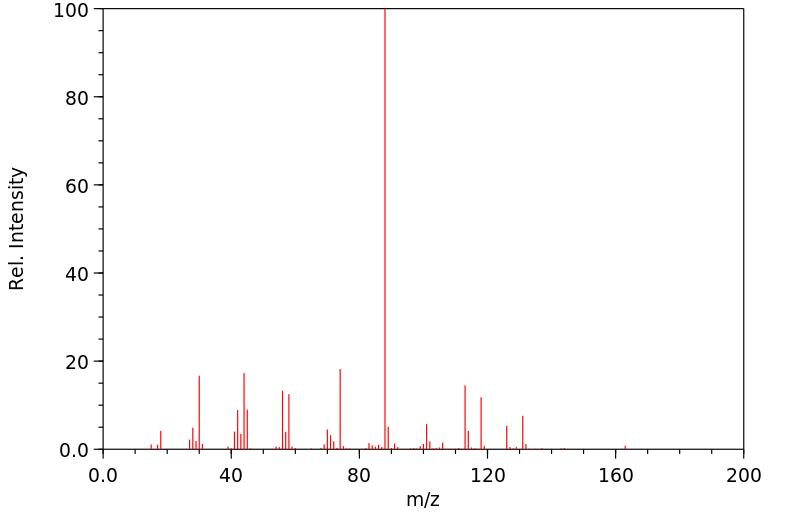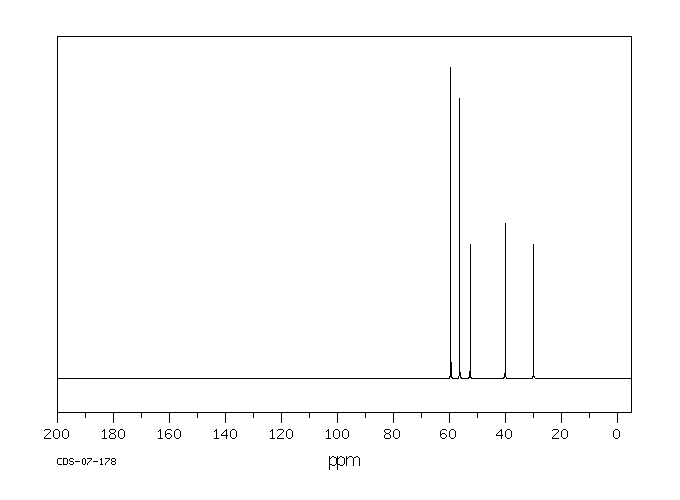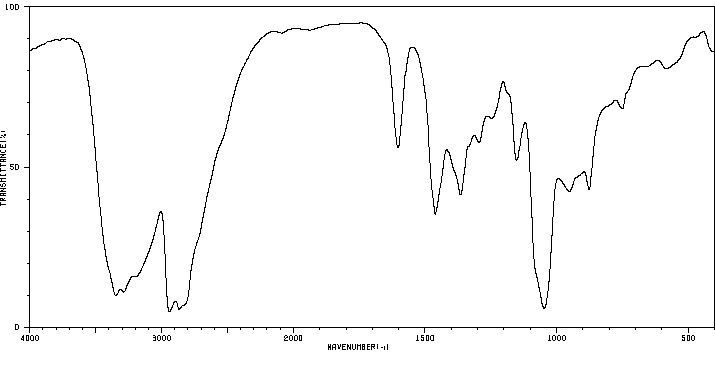N-(3-氨基丙基)二乙醇胺 | 4985-85-7
物质功能分类
中文名称
N-(3-氨基丙基)二乙醇胺
中文别名
二羟乙基-1,3-丙二胺;N,N-双(2-羟乙基)-1,3-二氨基丙烷;N-(3-氨丙基)二乙醇胺
英文名称
2,2'-[(3-aminopropyl)imino]bis-ethanol
英文别名
N-(3-Aminopropyl)diethanolamine;2-[3-aminopropyl(2-hydroxyethyl)amino]ethanol
CAS
4985-85-7
化学式
C7H18N2O2
mdl
MFCD00047971
分子量
162.232
InChiKey
FKJVYOFPTRGCSP-UHFFFAOYSA-N
BEILSTEIN
——
EINECS
——
-
物化性质
-
计算性质
-
ADMET
-
安全信息
-
SDS
-
制备方法与用途
-
上下游信息
-
文献信息
-
表征谱图
-
同类化合物
-
相关功能分类
-
相关结构分类
物化性质
-
沸点:207 °C
-
密度:1,07 g/cm3
-
闪点:138°C
-
溶解度:溶于水
-
LogP:-1.74 at 25℃
-
物理描述:Aminopropyldiethanolamine appears as a colorless liquid with a faint fishlike odor. May burn though it may require some effort to ignite. Corrosive to tissue. Produces toxic oxides of nitrogen during combustion.
-
稳定性/保质期:
在常温常压下保持稳定
计算性质
-
辛醇/水分配系数(LogP):-1.7
-
重原子数:11
-
可旋转键数:7
-
环数:0.0
-
sp3杂化的碳原子比例:1.0
-
拓扑面积:69.7
-
氢给体数:3
-
氢受体数:4
安全信息
-
危险等级:8
-
危险品标志:Xi
-
危险类别码:R34
-
危险品运输编号:2735
-
海关编码:2922199090
-
包装等级:III
-
危险类别:8
-
安全说明:S26,S36/37/39
-
危险性防范说明:P260,P264,P280,P301+P330+P331+P310,P303+P361+P353+P310+P363,P304+P340+P310,P305+P351+P338+P310,P405,P501
-
危险性描述:H314
-
储存条件:请将药品存放在避光、通风干燥的地方,并密封保存。
SDS
N-(3-Aminopropyl)diethanolamine Revision number: 1
SAFETY DATA SHEET
Section 1. BASE INFORMATION
Product name: N-(3-Aminopropyl)diethanolamine
Revision number: 1
Section 2. HAZARDS IDENTIFICATION
Classification of the GHS
PHYSICAL HAZARDS Not classified
HEALTH HAZARDS
Category 1C
Skin corrosion/irritation
Serious eye damage/eye irritation Category 1
Not classified
ENVIRONMENTAL HAZARDS
GHS label elements
Pictograms or hazard symbols
Signal word Danger
Hazard statement Causes severe skin burns and eye damage
Precautionary statements
[Prevention] Do not breathe.
Wash hands thoroughly after handling.
Wear protective gloves/eye protection/face protection.
[Response] IF INHALED: Remove victim to fresh air and keep at rest in a position comfortable for
breathing.
IF SWALLOWED: Rinse mouth. Do NOT induce vomiting.
IF IN EYES: Rinse cautiously with water for several minutes. Remove contact lenses,
if present and easy to do. Continue rinsing.
IF ON SKIN (or hair): Remove/Take off immediately all contaminated clothing. Rinse
skin with water/shower.
Wash contaminated clothing before reuse.
Immediately call a POISON CENTER or doctor/physician.
Store locked up.
[Storage]
[Disposal] Dispose of contents/container through a waste management company authorized by
the local government
Section 3. COMPOSITION/INFORMATION ON INGREDIENTS
Substance/mixture: Substance
Component(s): N-(3-Aminopropyl)diethanolamine
>90.0%(GC)
Percent:
CAS Number: 4985-85-7
N,N-Bis(2-hydroxyethyl)-1,3-diaminopropane
Synonyms:
Chemical Formula: C7H18N2O2
N-(3-Aminopropyl)diethanolamine
Section 4. FIRST AID MEASURES
Inhalation: Remove victim to fresh air and keep at rest in a position comfortable for breathing.
Immediately call a POISON CENTER or doctor/physician.
Skin contact: Remove/Take off immediately all contaminated clothing. Gently wash with plenty of
soap and water. Immediately call a POISON CENTER or doctor/physician.
Eye contact: Rinse cautiously with water for several minutes. Remove contact lenses, if present
and easy to do. Continue rinsing.Immediately call a POISON CENTER or
doctor/physician.
Ingestion: Immediately call a POISON CENTER or doctor/physician. Rinse mouth. Do NOT
induce vomiting.
burning sensation, difficulty in breathing, thirst, asthma, nausea, vomiting, bronchitis ,
Symptoms/effects:
diarrhoea, weakness, collapse, headache, redness, pain, burn
A rescuer should wear personal protective equipment, such as rubber gloves and air-
Protection of first-aiders:
tight goggles.
Section 5. FIRE-FIGHTING MEASURES
Suitable extinguishing Dry chemical, foam, water spray, carbon dioxide.
media:
Extinguishing media not to Solid streams of water
be used:
Specific hazards: Take care as it may decompose upon combustion or in high temperatures to
generate poisonous fume.
Specific methods: Fire-extinguishing work is done from the windward and the suitable fire-extinguishing
method according to the surrounding situation is used. Uninvolved persons should
evacuate to a safe place. In case of fire in the surroundings: Remove movable
containers if safe to do so.
Special protective When extinguishing fire, be sure to wear personal protective equipment.
equipment for firefighters:
Section 6. ACCIDENTAL RELEASE MEASURES
Personal precautions, Use extra personal protective equipment (self-contained breathing apparatus). Keep
protective equipment and people away from and upwind of spill/leak. Ensure adequate ventilation. Entry to non-
emergency procedures: involved personnel should be controlled around the leakage area by roping off, etc.
Environmental precautions: Prevent product from entering drains.
Methods and materials for Absorb spilled material in a suitable absorbent (e.g. rag, dry sand, earth, saw-dust).
containment and cleaning In case of large amount of spillage, contain a spill by bunding. Adhered or collected
up: material should be promptly disposed of, in accordance with appropriate laws and
regulations.
Section 7. HANDLING AND STORAGE
Handling
Technical measures: Handling is performed in a well ventilated place. Wear suitable protective equipment.
Prevent generation of vapor or mist. Wash hands and face thoroughly after handling.
Use a closed system if possible. Use a ventilation, local exhaust if vapor or aerosol
will be generated.
Advice on safe handling: Avoid contact with skin, eyes and clothing.
Storage
Storage conditions: Keep container tightly closed. Store in a cool and dark place.
Store under inert gas.
Protect from moisture.
Store locked up.
Store away from incompatible materials such as oxidizing agents.
Law is followed.
Packaging material:
Section 8. EXPOSURE CONTROLS / PERSONAL PROTECTION
Engineering controls: Install a closed system or local exhaust. Also install safety shower and eye bath.
N-(3-Aminopropyl)diethanolamine
Section 8. EXPOSURE CONTROLS / PERSONAL PROTECTION
Personal protective equipment
Respiratory protection: Half or full facepiece respirator, self-contained breathing apparatus(SCBA), supplied
air respirator, etc. Use respirators approved under appropriate government standards
and follow local and national regulations.
Hand protection: Impervious gloves.
Safety goggles. A face-shield, if the situation requires.
Eye protection:
Skin and body protection: Impervious protective clothing. Protective boots, if the situation requires.
Section 9. PHYSICAL AND CHEMICAL PROPERTIES
Physical state (20°C): Liquid
clear
Form:
Color: Colorless - Slightly pale yellow
Ammoniacal
Odor:
pH: 12
Melting point/freezing point:No data available
Boiling Point/Range: 207 °C
Flash Point: 138°C
Explosive limits
No data available
Lower:
Upper: No data available
5.6
Vapor Density:
Density: 1.07
Soluble in : Water
Solubility:
Section 10. STABILITY AND REACTIVITY
Stability: Stable under proper conditions.
Reactivity: No special reactivity has been reported.
Conditions to avoid: Hygroscopic
Incompartible materials: oxidizing agents, acids
Hazardous Decomposition Carbon monoxide, Carbon dioxide, Nitrogen oxides (NOx)
Products:
Section 11. TOXICOLOGICAL INFORMATION
No data available
Acute Toxicity:
Skin corrosion/irritation: No data available
No data available
Serious eye
damage/irritation:
Germ cell mutagenicity: No data available
Carcinogenicity:
No data available
IARC =
NTP = No data available
No data available
Reproductive toxicity:
Section 12. ECOLOGICAL INFORMATION
Ecotoxicity:
Fish: No data available
Crustacea: No data available
Algae: No data available
Persistence / degradability: No data available
Bioaccumulative No data available
potential(BCF):
Mobillity in soil
log Pow: No data available
Soil adsorption (Koc): No data available
Henry's Law No data available
constant(PaM3/mol):
N-(3-Aminopropyl)diethanolamine
Section 13. DISPOSAL CONSIDERATIONS
Recycle to process, if possible. Consult your local regional authorities. You may be able to burn in a chemical
incinerator equipped with an afterburner and scrubber system. Observe all federal, state and local regulations when
disposing of the substance.
Section 14. TRANSPORT INFORMATION
Hazards Class: 8: Corrosive.
UN-No: 2735
Polyamines, liquid, corrosive, n.o.s.
Proper shipping name:
Packing group: III
Section 15. REGULATORY INFORMATION
Safe management ordinance of dangerous chemical product (State Council announces on January 26,
2002): Safe use and production, the storage of a dangerous chemical, transport, loading and unloading were
prescribed.
SECTION 16 - ADDITIONAL INFORMATION
N/A
SAFETY DATA SHEET
Section 1. BASE INFORMATION
Product name: N-(3-Aminopropyl)diethanolamine
Revision number: 1
Section 2. HAZARDS IDENTIFICATION
Classification of the GHS
PHYSICAL HAZARDS Not classified
HEALTH HAZARDS
Category 1C
Skin corrosion/irritation
Serious eye damage/eye irritation Category 1
Not classified
ENVIRONMENTAL HAZARDS
GHS label elements
Pictograms or hazard symbols
Signal word Danger
Hazard statement Causes severe skin burns and eye damage
Precautionary statements
[Prevention] Do not breathe.
Wash hands thoroughly after handling.
Wear protective gloves/eye protection/face protection.
[Response] IF INHALED: Remove victim to fresh air and keep at rest in a position comfortable for
breathing.
IF SWALLOWED: Rinse mouth. Do NOT induce vomiting.
IF IN EYES: Rinse cautiously with water for several minutes. Remove contact lenses,
if present and easy to do. Continue rinsing.
IF ON SKIN (or hair): Remove/Take off immediately all contaminated clothing. Rinse
skin with water/shower.
Wash contaminated clothing before reuse.
Immediately call a POISON CENTER or doctor/physician.
Store locked up.
[Storage]
[Disposal] Dispose of contents/container through a waste management company authorized by
the local government
Section 3. COMPOSITION/INFORMATION ON INGREDIENTS
Substance/mixture: Substance
Component(s): N-(3-Aminopropyl)diethanolamine
>90.0%(GC)
Percent:
CAS Number: 4985-85-7
N,N-Bis(2-hydroxyethyl)-1,3-diaminopropane
Synonyms:
Chemical Formula: C7H18N2O2
N-(3-Aminopropyl)diethanolamine
Section 4. FIRST AID MEASURES
Inhalation: Remove victim to fresh air and keep at rest in a position comfortable for breathing.
Immediately call a POISON CENTER or doctor/physician.
Skin contact: Remove/Take off immediately all contaminated clothing. Gently wash with plenty of
soap and water. Immediately call a POISON CENTER or doctor/physician.
Eye contact: Rinse cautiously with water for several minutes. Remove contact lenses, if present
and easy to do. Continue rinsing.Immediately call a POISON CENTER or
doctor/physician.
Ingestion: Immediately call a POISON CENTER or doctor/physician. Rinse mouth. Do NOT
induce vomiting.
burning sensation, difficulty in breathing, thirst, asthma, nausea, vomiting, bronchitis ,
Symptoms/effects:
diarrhoea, weakness, collapse, headache, redness, pain, burn
A rescuer should wear personal protective equipment, such as rubber gloves and air-
Protection of first-aiders:
tight goggles.
Section 5. FIRE-FIGHTING MEASURES
Suitable extinguishing Dry chemical, foam, water spray, carbon dioxide.
media:
Extinguishing media not to Solid streams of water
be used:
Specific hazards: Take care as it may decompose upon combustion or in high temperatures to
generate poisonous fume.
Specific methods: Fire-extinguishing work is done from the windward and the suitable fire-extinguishing
method according to the surrounding situation is used. Uninvolved persons should
evacuate to a safe place. In case of fire in the surroundings: Remove movable
containers if safe to do so.
Special protective When extinguishing fire, be sure to wear personal protective equipment.
equipment for firefighters:
Section 6. ACCIDENTAL RELEASE MEASURES
Personal precautions, Use extra personal protective equipment (self-contained breathing apparatus). Keep
protective equipment and people away from and upwind of spill/leak. Ensure adequate ventilation. Entry to non-
emergency procedures: involved personnel should be controlled around the leakage area by roping off, etc.
Environmental precautions: Prevent product from entering drains.
Methods and materials for Absorb spilled material in a suitable absorbent (e.g. rag, dry sand, earth, saw-dust).
containment and cleaning In case of large amount of spillage, contain a spill by bunding. Adhered or collected
up: material should be promptly disposed of, in accordance with appropriate laws and
regulations.
Section 7. HANDLING AND STORAGE
Handling
Technical measures: Handling is performed in a well ventilated place. Wear suitable protective equipment.
Prevent generation of vapor or mist. Wash hands and face thoroughly after handling.
Use a closed system if possible. Use a ventilation, local exhaust if vapor or aerosol
will be generated.
Advice on safe handling: Avoid contact with skin, eyes and clothing.
Storage
Storage conditions: Keep container tightly closed. Store in a cool and dark place.
Store under inert gas.
Protect from moisture.
Store locked up.
Store away from incompatible materials such as oxidizing agents.
Law is followed.
Packaging material:
Section 8. EXPOSURE CONTROLS / PERSONAL PROTECTION
Engineering controls: Install a closed system or local exhaust. Also install safety shower and eye bath.
N-(3-Aminopropyl)diethanolamine
Section 8. EXPOSURE CONTROLS / PERSONAL PROTECTION
Personal protective equipment
Respiratory protection: Half or full facepiece respirator, self-contained breathing apparatus(SCBA), supplied
air respirator, etc. Use respirators approved under appropriate government standards
and follow local and national regulations.
Hand protection: Impervious gloves.
Safety goggles. A face-shield, if the situation requires.
Eye protection:
Skin and body protection: Impervious protective clothing. Protective boots, if the situation requires.
Section 9. PHYSICAL AND CHEMICAL PROPERTIES
Physical state (20°C): Liquid
clear
Form:
Color: Colorless - Slightly pale yellow
Ammoniacal
Odor:
pH: 12
Melting point/freezing point:No data available
Boiling Point/Range: 207 °C
Flash Point: 138°C
Explosive limits
No data available
Lower:
Upper: No data available
5.6
Vapor Density:
Density: 1.07
Soluble in : Water
Solubility:
Section 10. STABILITY AND REACTIVITY
Stability: Stable under proper conditions.
Reactivity: No special reactivity has been reported.
Conditions to avoid: Hygroscopic
Incompartible materials: oxidizing agents, acids
Hazardous Decomposition Carbon monoxide, Carbon dioxide, Nitrogen oxides (NOx)
Products:
Section 11. TOXICOLOGICAL INFORMATION
No data available
Acute Toxicity:
Skin corrosion/irritation: No data available
No data available
Serious eye
damage/irritation:
Germ cell mutagenicity: No data available
Carcinogenicity:
No data available
IARC =
NTP = No data available
No data available
Reproductive toxicity:
Section 12. ECOLOGICAL INFORMATION
Ecotoxicity:
Fish: No data available
Crustacea: No data available
Algae: No data available
Persistence / degradability: No data available
Bioaccumulative No data available
potential(BCF):
Mobillity in soil
log Pow: No data available
Soil adsorption (Koc): No data available
Henry's Law No data available
constant(PaM3/mol):
N-(3-Aminopropyl)diethanolamine
Section 13. DISPOSAL CONSIDERATIONS
Recycle to process, if possible. Consult your local regional authorities. You may be able to burn in a chemical
incinerator equipped with an afterburner and scrubber system. Observe all federal, state and local regulations when
disposing of the substance.
Section 14. TRANSPORT INFORMATION
Hazards Class: 8: Corrosive.
UN-No: 2735
Polyamines, liquid, corrosive, n.o.s.
Proper shipping name:
Packing group: III
Section 15. REGULATORY INFORMATION
Safe management ordinance of dangerous chemical product (State Council announces on January 26,
2002): Safe use and production, the storage of a dangerous chemical, transport, loading and unloading were
prescribed.
SECTION 16 - ADDITIONAL INFORMATION
N/A
上下游信息
-
上游原料
中文名称 英文名称 CAS号 化学式 分子量 N-(2-氰乙基)二乙醇胺 3-[bis(2-hydroxyethyl)amino]propionitrile 17209-72-2 C7H14N2O2 158.2 -
下游产品
中文名称 英文名称 CAS号 化学式 分子量 —— 2,2'-<3-<(3-Amino-propyl)-amino>-propylimino>-diaethanol 91819-84-0 C10H25N3O2 219.327 —— N,N-bis(2-hydroxyethyl)-N'-octadecyl-1,3-propanediamine 37516-62-4 C25H54N2O2 414.716 阿夫立定 N,N-dioctadecyl-N',N'-bis(2-hydroxyethyl)1,3-propanediamine 35607-20-6 C43H90N2O2 667.2 2-[{3-[二(2-羟基乙基)氨基]丙基}(十八烷基)氨基]乙醇 N,N,N'-tris-(2-hydroxyethyl)-N'-octadecyl-1,3-diaminopropane 17671-49-7 C27H58N2O3 458.769 —— N,N'-Bis{3-[bis(2-hydroxyethyl)amino]propyl}urea 515851-10-2 C15H34N4O5 350.459
反应信息
-
作为反应物:参考文献:名称:一系列脂肪族二胺的合成和CMC测定。摘要:十五个被一个长烷基链(C10-C18)取代的脂肪族二胺,不同数目的亚甲基分隔了氮原子(两个至六个),合成了各种脂肪族取代基,并确定了它们的CMC。尽管长烷基链的长度在影响CMC方面起主要作用,但其他N-烷基取代基以及将二胺的两个氮隔开的亚甲基链的长度是重要因素。DOI:10.1002/jps.2600640540
-
作为产物:描述:N-(2-氰乙基)二乙醇胺 在 lithium aluminium tetrahydride 、 硫酸 作用下, 以 四氢呋喃 为溶剂, 反应 8.0h, 以32%的产率得到N-(3-氨基丙基)二乙醇胺参考文献:名称:钴与不对称三足配体的络合摘要:脂肪族不对称三脚架 [N(CH2CH2NH2)2(CH2CH2OH)], H5-1 与氯化钴 (II) 在四氢呋喃中的反应在空气氧化后产生双核复合物 [(H4-1)CoIII(μ-OH)CoIII (H4-1)](CoIICl4)Cl, [5](CoCl4)Cl。三阴离子 53- 包含由单去质子化配体 (H4-1)- 的两个烷氧基和一个羟基三重桥接的两个钴原子。新配体 [N(CH2CH2CH2NH2)(CH2CH2OH)2]、H4-3,提供 N2O2 供体组与氯化钴 (II) 反应,在空气氧化后得到六核配合物 [CoIII4(H2-3)4CoII2(HOMe)2Cl2 (μ-OH)4]、[6]Cl2,包含前所未有的混合价 CoIII4CoII2 核心。DOI:10.1515/znb-2005-0610
文献信息
-
Sulfonamides having antiangiogenic and anticancer activity申请人:——公开号:US20040157836A1公开(公告)日:2004-08-12Compounds having methionine aminopeptidase-2 inhibitory (MetAP2) are described. Also described are pharmaceutical compositions comprising the compounds, methods of treatment using the compounds, methods of inhibiting angiogenesis, and methods of treating cancer.
-
Substituted amine derivatives, their production and use申请人:Takeda Chemical Industries, Ltd.公开号:US04987130A1公开(公告)日:1991-01-22Substituted amino derivatives represented by the formula: ##STR1## wherein R.sup.1 and R.sup.2 each stand for an acyclic hydrocarbon residue or an alicyclic hydrocarbon residue; R.sup.3 and R.sup.4 each stand for hydrogen or a hydrocarbon residue optionally containing hetero-atom(s); A stands for a carbon chain having two or more carbon atoms optionally containing ether linkage or sulfide linkage, which may be substituted and which may per se form a ring; X.sup.1 and X.sup.2 each stand for oxygen atom or sulfur atom; and Y stands for amino group or an organic residue bonded through nitrogen atom, which may form a ring by combining with a carbon atom constituting A; and their salts have anti-arrhythmic activity and are useful for prevention and treatment of a variety of arrhythmias.
-
Aldimines of Cardenolides and Cardenolide-Glycosides作者:I. F. Makarevich、Yu. I. Gubin、R. MeggesDOI:10.1007/s10600-005-0142-7日期:2005.5New aldimines were synthesized from the cardenolide strophantidin and cardenolide-glycosides erysimin and cymarin and included morpholine, nitrile, pyridine, furan, hydroxy- and methoxyphenyl, piperidine, and other derivatives. An effective modified method for synthesizing aldimines was proposed. 52 new compounds were synthesized. Their structures were confirmed by IR and PMR spectra and elemental analysis.
-
Inhibitors of checkpoint kinases (Wee1 and Chk1)申请人:Booth John Richard公开号:US20050250836A1公开(公告)日:2005-11-10This invention relates to substituted indacene molecules that specifically inhibit one or both of the checkpoint kinases Wee1 and Chk1 and are useful in the treatment of proliferative disorders.这项发明涉及替代的吲哚烯分子,特异性地抑制检查点激酶Wee1和Chk1中的一个或两个,并在治疗增殖性疾病中有用。
-
[EN] C-28 AMINES OF C-3 MODIFIED BETULINIC ACID DERIVATIVES AS HIV MATURATION INHIBITORS<br/>[FR] AMINES EN C28 DE DÉRIVÉS D'ACIDE BÉTULINIQUE MODIFIÉ EN C-3 EN TANT QU'INHIBITEURS DE MATURATION DU VIH申请人:BRISTOL MYERS SQUIBB CO公开号:WO2012106188A1公开(公告)日:2012-08-09Compounds having drug and bio-affecting properties, their pharmaceutical compositions and methods of use are set forth. In particular, C-28 amines of C-3 modified betulinic acid derivatives that possess unique antiviral activity are provided as HIV maturation inhibitors. These compounds are useful for the treatment of HIV and AIDS. In particular, the following compounds are provided herein, including pharmaceutically acceptable salts thereof: a compound of formula (I), a compound of formula (II), and a compound of formula (III).
表征谱图
-
氢谱1HNMR
-
质谱MS
-
碳谱13CNMR
-
红外IR
-
拉曼Raman
-
峰位数据
-
峰位匹配
-
表征信息
同类化合物
(乙腈)二氯镍(II)
(R)-(-)-α-甲基组胺二氢溴化物
(N-(2-甲基丙-2-烯-1-基)乙烷-1,2-二胺)
(4-(苄氧基)-2-(哌啶-1-基)吡啶咪丁-5-基)硼酸
(11-巯基十一烷基)-,,-三甲基溴化铵
鼠立死
鹿花菌素
鲸蜡醇硫酸酯DEA盐
鲸蜡硬脂基二甲基氯化铵
鲸蜡基胺氢氟酸盐
鲸蜡基二甲胺盐酸盐
高苯丙氨醇
高箱鲀毒素
高氯酸5-(二甲氨基)-1-({(E)-[4-(二甲氨基)苯基]甲亚基}氨基)-2-甲基吡啶正离子
高氯酸2-氯-1-({(E)-[4-(二甲氨基)苯基]甲亚基}氨基)-6-甲基吡啶正离子
高氯酸2-(丙烯酰基氧基)-N,N,N-三甲基乙铵
马诺地尔
马来酸氢十八烷酯
马来酸噻吗洛尔EP杂质C
马来酸噻吗洛尔
马来酸倍他司汀
顺式环己烷-1,3-二胺盐酸盐
顺式氯化锆二乙腈
顺式吡咯烷-3,4-二醇盐酸盐
顺式双(3-甲氧基丙腈)二氯铂(II)
顺式3,4-二氟吡咯烷盐酸盐
顺式1-甲基环丙烷1,2-二腈
顺式-二氯-反式-二乙酸-氨-环己胺合铂
顺式-二抗坏血酸(外消旋-1,2-二氨基环己烷)铂(II)水合物
顺式-N,2-二甲基环己胺
顺式-4-甲氧基-环己胺盐酸盐
顺式-4-环己烯-1.2-二胺
顺式-4-氨基-2,2,2-三氟乙酸环己酯
顺式-3-氨基环丁烷甲腈盐酸盐
顺式-2-羟基甲基-1-甲基-1-环己胺
顺式-2-甲基环己胺
顺式-2-(苯基氨基)环己醇
顺式-2-(苯基氨基)环己醇
顺式-2-(氨基甲基)-1-苯基环丙烷羧酸盐酸盐
顺式-1,3-二氨基环戊烷
顺式-1,2-环戊烷二胺二盐酸盐
顺式-1,2-环戊烷二胺
顺式-1,2-环丁腈
顺式-1,2-双氨甲基环己烷
顺式--N,N'-二甲基-1,2-环己二胺
顺式-(R,S)-1,2-二氨基环己烷铂硫酸盐
顺式-(2-氨基-环戊基)-甲醇
顺-2-戊烯腈
顺-1,3-环己烷二胺
顺-1,3-双(氨甲基)环己烷









